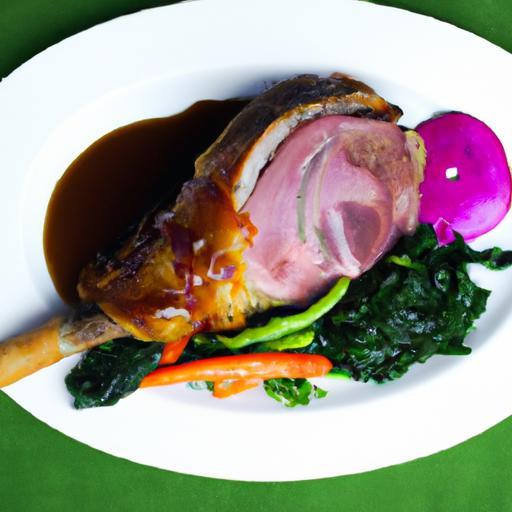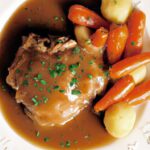There’s a quiet magic in the slow simmer of a stew, a transformative alchemy where tough, unyielding cuts of meat surrender to tender perfection. Behind this culinary enchantment lies a fascinating dance of science and patience, where time and temperature work in harmony to unlock deep, rich flavors hidden within every sinew and fiber. In this article, we’ll journey beneath the surface of slow cooking to explore the molecular secrets that turn chewy toughness into melt-in-your-mouth succulence. Prepare to discover how slow cooking isn’t just a method-it’s an artful science that elevates humble cuts into gourmet delights.
Understanding Connective Tissue and Its Transformation in Slow Cooking
Unlocking flavor through slow cooking begins with appreciating how connective tissue in tough cuts of meat transforms during the process, turning what might seem like an intimidating slab into a tender, succulent dish. These tougher cuts, rich in collagen, usually come from muscles that work harder, such as brisket, chuck, or shank. Collagen, the main structural protein in connective tissue, breaks down into gelatin as it slowly cooks, infusing the meat with a silky texture and deep mouthfeel that’s simply irresistible.
The Role of Collagen Breakdown in Tenderizing Tough Cuts
When collagen is exposed to low, consistent heat over an extended period, it slowly denatures and converts into gelatin. This transformation is pivotal, as gelatin enhances moisture retention and creates a luscious, unctuous sauce naturally thickened by the meat itself. Collagen breakdown not only tenderizes the meat, making it fork-tender, but it also amplifies the depth of flavor, giving slow-cooked dishes their signature rich, satisfying essence.
Optimal Temperature and Timing for Maximum Flavor Extraction
For perfect gelatinization, maintaining cooking temperatures between 190°F and 210°F (88°C to 99°C) is key. These temperatures allow collagen to dissolve gradually without overcooking the meat fibers. Slow cooking at low heat, whether in a crockpot, oven, or sous vide, requires patience-generally ranging from 4 to 8 hours depending on the cut and size. Cooking too quickly or too hot can cause muscle fibers to stiffen, resulting in a dry, tough texture rather than the velvety melt-in-your-mouth experience slow cooking promises.
Choosing the Right Cuts and Enhancing Flavor with Marinades and Spice Rubs
Unlocking flavor’s foundation relies heavily on selecting the appropriate cuts. Cuts like beef brisket, pork shoulder, lamb shanks, or oxtail are classics because they contain enough connective tissue to benefit from slow cooking. To add layers of complexity, introduce marinades rich in acids like vinegar or citrus juice that subtly break down muscle fibers before cooking. Coupling these with bold spice rubs-including smoked paprika, cumin, garlic powder, and black pepper-builds a fragrant crust and infuses the meat with savory, aromatic notes.
Prep and Cook Time
- Preparation: 20 minutes
- Marinating (optional): 4-12 hours
- Cooking: 6 hours low and slow
Yield
Servings: 6-8
Difficulty Level
Medium-requires planning and patience but minimal active cooking time
Ingredients
- 3 lbs beef brisket, trimmed
- 1 cup beef broth
- 1/2 cup apple cider vinegar
- 2 tbsp olive oil
- 1 tbsp smoked paprika
- 2 tsp garlic powder
- 1 tsp ground cumin
- 1 tsp black pepper
- 1 tsp kosher salt
- 1 large onion, sliced
- 4 cloves garlic, smashed
- 2 bay leaves
Instructions
- Mix the marinade: Combine apple cider vinegar, olive oil, smoked paprika, garlic powder, cumin, black pepper, and kosher salt in a bowl to create a robust spice rub.
- Prepare the brisket: Rub the spice mixture generously over the entire brisket. For deeper flavor and tenderness, marinate in the refrigerator for at least 4 hours or overnight.
- Sear the meat: Heat a heavy skillet over medium-high heat. Sear the brisket on all sides until golden brown, about 3 minutes per side, to lock in juices and develop flavor.
- Setup for slow cooking: Place the sliced onion and smashed garlic in the bottom of a slow cooker or Dutch oven. Nestle the seared brisket on top, add bay leaves, then pour beef broth around (not over) the meat to keep the rub intact.
- Slow cook low and slow: Cook on low heat for 6-8 hours until the meat becomes tender and easily pulls apart with a fork. Resist the urge to disturb the brisket often to retain moisture.
- Rest and serve: After cooking, let the brisket rest for 15 minutes before slicing against the grain. This further enhances tenderness and ensures juicy bites.
Chef’s Notes & Tips for Success
- Variation tip: Swap beef brisket with pork shoulder or lamb shanks for a different flavor profile but similar collagen-rich transformation.
- Marinade boost: Adding fresh herbs like rosemary or thyme to the marinade infuses fragrant layers to your dish.
- Make-ahead: This dish tastes even better the next day as flavors meld – refrigerate for up to 3 days or freeze portions for later meals.
- Troubleshooting: If the meat feels tough after cooking, it likely needs more time for collagen to fully break down-extend cooking by 1-2 hours and check again.
Serving Suggestions
Pair this melt-in-your-mouth slow-cooked brisket with creamy mashed potatoes or buttery polenta to complement its richness. Garnish with freshly chopped parsley or a sprinkle of smoked paprika to brighten the visual presentation. Serve alongside roasted root vegetables or a tangy coleslaw to balance the deep flavors with freshness and crunch.
| Nutrient | Amount (per serving) |
|---|---|
| Calories | 410 kcal |
| Protein | 38 g |
| Carbohydrates | 6 g |
| Fat | 24 g |

Unlocking flavor rests not just in simple cooking but in understanding the science beneath the surface. Embrace the magic of collagen breakdown, controlled temperature, and thoughtful seasoning to transform everyday ingredients into extraordinary meals that nourish both body and soul.
Q&A
Q&A: Unlocking Flavor – The Science Behind Slow Cooking Tough Meat
Q1: Why does slow cooking transform tough cuts of meat into tender, flavorful dishes?
A1: Tough cuts of meat are rich in collagen, a connective tissue that makes muscles dense and chewy. When cooked slowly at low temperatures, collagen breaks down into gelatin, which dissolves and creates a silky, luscious texture. This process not only tenderizes the meat but also locks in moisture and enhances the overall flavor, making every bite a melt-in-your-mouth experience.
Q2: How does temperature affect the breakdown of tough meat fibers during slow cooking?
A2: Temperature is the maestro in this culinary symphony. Slow cooking typically occurs between 170°F to 205°F (77°C to 96°C), a gentle heat that persuades collagen to unravel without toughening proteins. Cooking too hot, too fast can contract muscle fibers and squeeze out moisture, leaving meat dry and chewy. Low and steady heat allows enzymes and collagen to work their magic over time, turning toughness into tenderness.
Q3: Is slow cooking better for all types of tough meats?
A3: Most tough, fibrous cuts benefit immensely from slow cooking – think brisket, chuck roast, pork shoulder, and short ribs. These cuts contain more connective tissue and fat, which melt slowly, enriching the meat’s texture and flavor. However, lean cuts with minimal collagen, like sirloin or tenderloin, may dry out if slow-cooked too long, so they’re better suited to quicker, high-heat techniques.
Q4: What role do moisture and liquids play during slow cooking tough meat?
A4: Moisture is a slow cooker’s loyal ally. Using broth, wine, or even water creates a humid environment that helps transfer heat evenly and prevents the meat from drying out. The liquid also absorbs the meat’s natural juices and flavors, turning into a rich, savory sauce that complements the tender meat. This symbiotic relationship elevates the dish beyond a mere roast into a comfort-food masterpiece.
Q5: Can slow cooking enhance the flavor of marinade or seasoning in tough meats?
A5: Absolutely! Slow cooking acts like a flavor incubator. As the meat slowly breaks down, it absorbs the spices, herbs, and marinades used, allowing complex flavors to penetrate deep into each fiber. Over hours, the aromatics meld and mellow, creating a well-rounded, soulful profile that makes slow-cooked dishes deeply satisfying.
Q6: How do resting and slicing affect the final texture after slow cooking tough meat?
A6: Resting is the final secret step. After slow cooking, letting the meat rest for 10-20 minutes allows the juices to redistribute instead of spilling onto the cutting board. When slicing, cutting against the grain shortens muscle fibers, making each piece easier to chew. Together, these finishing touches maximize tenderness and ensure every bite reveals the full glory of your slow-cooked creation.
Q7: Are there any tips to optimize slow cooking tough meat for home cooks?
A7: Yes! Start with a good sear to develop a flavorful crust and Maillard reaction before slow cooking. Use a meat thermometer to avoid overcooking – the ideal range for tender tough meat is usually around 190°F to 205°F internal temperature. Finally, be patient; slow cooking is a lesson in the art of waiting, and the payoff is a richly textured, deeply delicious meal well worth the time.
To Conclude
As the final embers of a slow-cooked meal fade into the memory of your taste buds, the true magic reveals itself-not just in the tenderness of the meat, but in the intricate dance of science and patience behind it. Unlocking flavor through slow cooking is more than a method; it’s a culinary symphony where time, temperature, and texture harmonize to transform toughness into melt-in-your-mouth perfection. So next time you face a humble cut of meat, remember: beneath its rugged exterior lies a world of savory potential waiting to be unlocked-one slow, deliberate hour at a time.


